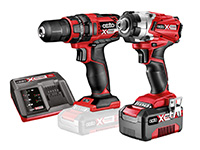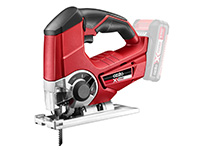DIY WORKBENCH

Work socks? Or a new work bench? Put those socks back. Your Dad certainly doesn’t need another pair. Get creative and try our DIY work bench project. You can thank us later!
Recommended Tools:

Step 1:
Decide on the size of the bench you want and the thickness of the plywood. We’ve gone with 21mm plywood and a 900mm x 900mm bench size.
Top Tip: Head to Bunnings and they will be able to cut the plywood to the specific dimensions you ask for!
Step 2:
Grab yourself some spare timber and place them under your first two pieces of plywood. Make sure they are squarely on the bench.
Step 3:
Now you need to mark up where you are going to make your cuts, so all the piece can go together. Measure 200mm from the side and 400mm deep and draw a centre line.
Step 4:
Clamp the plywood down and grab a forstner bit which should be a few millimetres longer than the plywood. Once you’ve popped on your safety glasses, grab the 18V Compact Drill and drill one hole through the two pieces of ply on either side of your markings (after completing in step 3).
Step 5:
Now you can mark out the trenches, draw a line closest to the holes as possible. This is where you cut out the inner parts, so the table can slot together. Grab the 18V Circular Saw and adjust the blade accordingly. Before you begin cutting, you’ll need to clamp down a straight edge to help guide your saw as you cut through the plywood. Grab the 18V Jigsaw to finish the cuts all the way through. You’ve now created your first two legs!
Step 6:
To create your second two legs, you need to grab 2 more pieces of plywood and mark it up as you did in step 3. Repeat step 4 and 5 too!
Step 7:
Now assemble all your legs together. To make sure your bench top is stable, grab some off-cut pieces of ply. Use a pencil to mark up the table tops outer edges on the opposing sides. Now align the off cuts to the inner most line and drill down – they should be parallel to one another. And finally, flip the bench so your table top should sit snug, level and of course – ready to use for your next DIY project.



